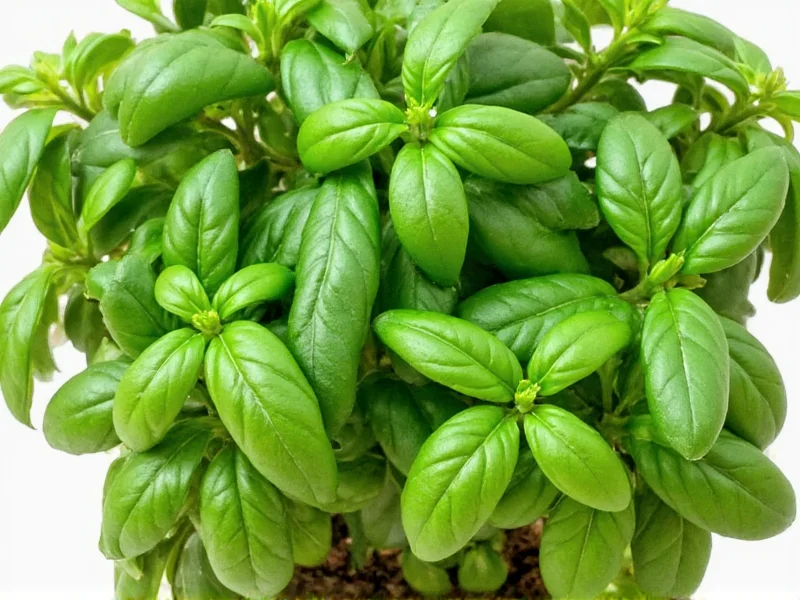Understanding herb conversions is essential for consistent cooking results. When substituting dried basil for fresh in recipes, you need significantly less dried herb because the drying process concentrates the flavor compounds. The moisture removal during drying means dried basil delivers more intense flavor per volume than its fresh counterpart.
Why the 1:3 Conversion Ratio Makes Sense
Fresh basil contains approximately 90% water, which evaporates during the drying process. What remains is a more potent concentration of essential oils and flavor compounds. This scientific principle explains why you need less dried basil to achieve similar flavor intensity as fresh.
Chefs and food scientists agree that the 1:3 ratio provides the most reliable conversion for basil specifically. Unlike some herbs that might follow a 1:4 ratio, basil's delicate flavor profile works best with this slightly less concentrated conversion.
Detailed Basil Conversion Chart
| Dried Basil | Fresh Basil Equivalent | Common Recipe Measurement |
|---|---|---|
| ¼ teaspoon | ¾ teaspoon | Small batch dressings |
| ½ teaspoon | 1½ teaspoons | Sauces for 2-4 servings |
| 1 teaspoon | 1 tablespoon | Standard recipe measurement |
| 1 tablespoon | 3 tablespoons (¼ cup) | Larger recipes or batches |
| 2 tablespoons | 6 tablespoons (⅓ cup) | Family-sized dishes |
When to Add Dried vs. Fresh Basil During Cooking
The timing of when you add basil to your dish significantly impacts the final flavor profile:
- Dried basil should be added early in the cooking process (15-20 minutes before completion) to allow time for rehydration and flavor release
- Fresh basil is best added in the last 2-3 minutes of cooking or used as a garnish to preserve its delicate flavor and vibrant color
Adding dried herbs too late results in a dusty, underdeveloped flavor, while cooking fresh basil too long causes it to lose its bright character and turn black.
Flavor Differences to Consider
While the 1:3 conversion works well for most recipes, be aware that dried and fresh basil have subtle flavor differences:
- Fresh basil offers bright, sweet notes with hints of anise and pepper
- Dried basil develops earthier, slightly more muted flavors with subtle woody notes
- Fresh basil works better in raw applications like pesto or caprese salad
- Dried basil performs better in long-simmered sauces and stews
Practical Tips for Best Results
Follow these professional kitchen tips when substituting between dried and fresh basil:
- Crush dried basil between your fingers before adding to release essential oils
- Store dried basil properly in airtight containers away from light to maintain potency (loses flavor after 6-12 months)
- Adjust to taste after initial conversion - some dried basil varieties vary in strength
- Reconstitute dried basil in a small amount of warm water or broth before adding to cold dishes
- Consider the dish type - delicate dishes may need slightly less dried basil than the standard ratio
Common Conversion Mistakes to Avoid
Many home cooks make these errors when substituting dried for fresh basil:
- Using equal measurements (1:1 ratio) resulting in overpowering flavor
- Adding dried basil at the same stage as fresh basil
- Not accounting for the age of dried herbs (older = less potent)
- Using dried basil in applications where fresh is essential (like garnishes)
- Measuring dried herbs without breaking up clumps, leading to inconsistent amounts
Special Considerations for Different Recipes
Certain dishes require adjustments to the standard conversion ratio:
- Pesto: Use fresh basil exclusively for authentic flavor and texture
- Tomato sauces: Dried basil works well with 1:3 ratio, added at beginning of simmer
- Salad dressings: Fresh basil preferred, but if using dried, use 1:4 ratio and let sit 30 minutes to rehydrate
- Marinades: Dried basil works better with 1:3 ratio as it has time to rehydrate
- Baked goods: Dried basil preferred with standard 1:3 conversion
Testing Your Conversion
The most reliable method for perfect basil substitution:
- Start with the standard 1:3 conversion ratio
- Add the herb incrementally, tasting as you go
- Remember that flavors intensify as dishes cook and sit
- When in doubt, under-season slightly - you can always add more but can't remove excess
Professional chefs recommend making small test batches when converting recipes that rely heavily on basil's flavor profile, such as Italian tomato sauces or Thai basil dishes.
Can I use dried basil instead of fresh in pesto?
No, dried basil doesn't work well for traditional pesto. The drying process removes the moisture and oils essential for pesto's texture and fresh flavor profile. For authentic pesto, always use fresh basil leaves for the best results.
Does the quality of dried basil affect the conversion ratio?
Yes, older dried basil loses potency over time. If your dried basil is more than 6 months old, you may need to use slightly more than the standard 1:3 ratio. Always check dried herbs for strong aroma before using - weak smell indicates reduced potency.
Why does my dish taste different when I substitute dried for fresh basil?
Dried and fresh basil have different flavor profiles beyond just intensity. Drying changes the chemical composition, creating earthier notes while losing some of the bright, sweet characteristics of fresh basil. This is why some dishes work better with one form over the other, regardless of proper measurement conversion.
How should I store dried basil to maintain its potency?
Store dried basil in an airtight container away from light, heat, and moisture. A dark cupboard is better than refrigerator storage, which can introduce moisture. Properly stored, dried basil maintains good flavor for 6-12 months. Check potency by rubbing a small amount between your fingers - strong aroma indicates good quality.











 浙公网安备
33010002000092号
浙公网安备
33010002000092号 浙B2-20120091-4
浙B2-20120091-4